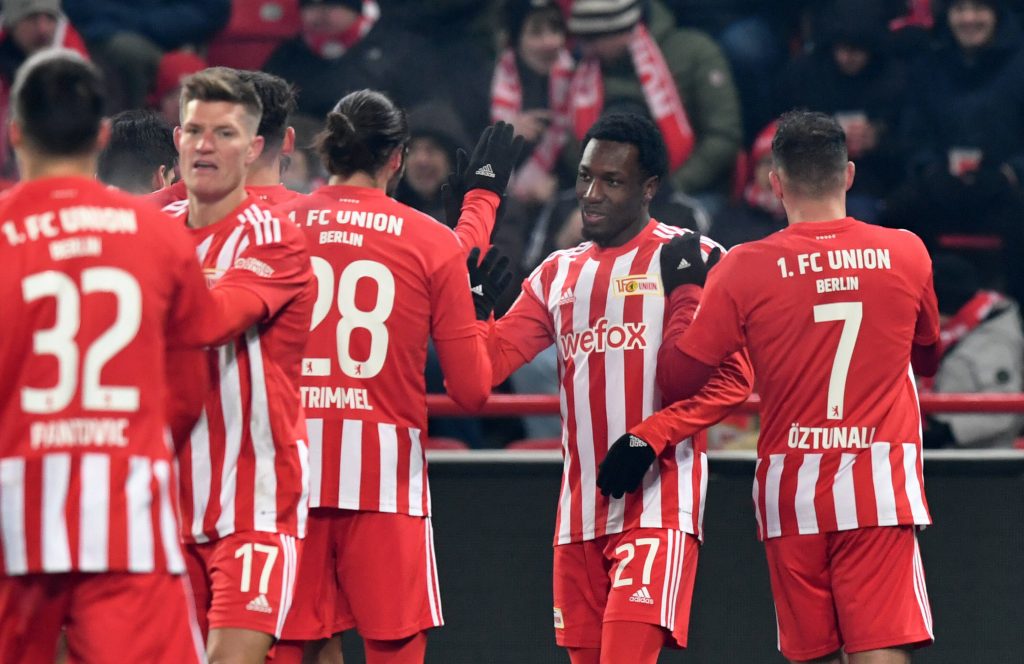Ninad Barbadikar looks at the Berlin side, who only joined the Bundesliga in 2019 for the first time but continue to impress with a functional approach
German football is perhaps most recently famous for its development of Gegenpressing, and the Bundesliga is perceived as the home of Gegenpressing. Jurgen Klopp’s Borussia Dortmund were the embodiment of Gegenpressing and several German coaches have since imbibed and embodied the principles in their tactical philosophies. Ralf Rangnick’s entire ethos to develop the Red Bull style of playing was to develop teams with the approach in mind. Problem solving in possession was secondary: what was important was to win the ball back as quickly as one could and advance it into forward areas while the opposition defenders were still reeling from the aggressive press. As Klopp famously said, “No playmaker in the world can be as good as a good counter-pressing situation.”
Union Berlin, however, are the exact opposite of a Gegenpressing side; one might call them an anti-gegenpressing side. But they’ve found success playing a certain way, and they continue to defy odds and exceed expectations, hopes and underlying numbers, year in, year out.
Urs Fischer has taken the Berlin outfit from the 2.Bundesliga to competing in European competitions. The club, who are also associated with a certain outlook politically and ethically and have attracted a lot of neutral support on this basis, have also shown that they can produce on the pitch. But their success in qualifying for European competitions in back to back seasons has been built on a style that’s not commonly associated with clubs that aspire to qualify for those competitions.
Union Berlin do not press intensively
As mentioned previously, Union Berlin are in many ways an anti-Gegenpressing side. They almost never press opponents high up the pitch and instead trust their ability to turn opposition turnovers into opportunities themselves.

When Union originally moved up to the Bundesliga, they were still relatively close to the league average in terms of PPDA, a metric which gives us some information about how intensely teams press their opponents on the pitch. In recent seasons, however, they’ve become less inclined to press and have become far, far more selective in the moments in which they will decide to chase the ball.

The above scenario is their match against Bayer Leverkusen in the Bundesliga earlier this season. Leverkusen (red) are in possession of the ball with Tapsoba playing a simple straight pass through to Robert Andrich, who is about to be pressed by Rani Khedira.
Notice how Union are man-oriented in their out of possession approach. In doing this, they risk getting beaten in individual battles, especially against sides that will outmatch them in terms of baseline quality. However, the benefit that Union give themselves with their approach is that although they are man-oriented, they are only defending in their own half of the pitch and only about 35 yards in front of their goal. Against Leverkusen, it was not enormously successful: Union lost 0-5.
It was a similar story against Freiburg where Union conceded four first half goals on the way to losing 4-1 against Christian Streich’s side away from home. The second half became all about damage limitation when Fischer brought on Paul Jaeckel to replace Sheraldo Becker as they defended against Freiburg with just 10 men on the field after Diogo Leite saw red in the first half. Nonetheless, you can see how the structure remains very similar.
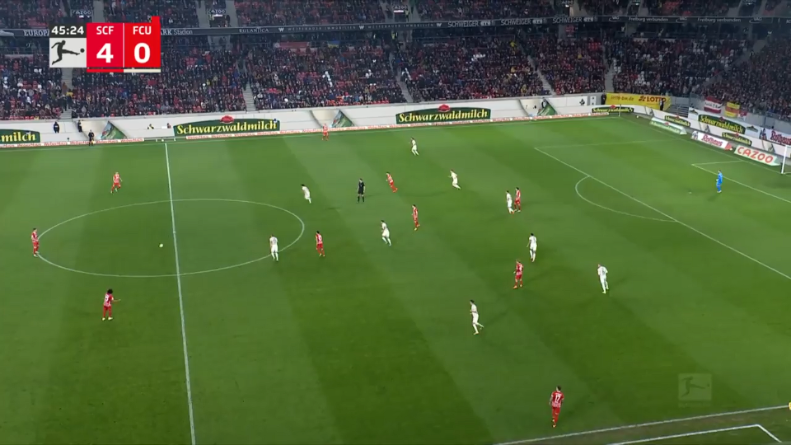
Those two results, coming in Union’s last three games, paint an alarming picture, but this is an approach that has been masterful until this point (and will almost certainly be again). Indeed, Union have conceded the lowest xG from open-play in the Bundesliga this season (9.61), according to the Analyst. Indeed, using FBref’s data via Opta, these two fixtures (Leverkusen away and Freiburg away) account for 4.2 of Union’s total expected goals against (although it’s worth noting there is a disparity between the total xGA on FBref, 15.7, and the Analyst, 13.4, even though both sites use Opta data, which is probably accounted for by the Analyst providing npXGA).
Ordinarily, then, Union’s defensive structure has obviously done much to limit the oppositions’ chance creating ability. The scenario below is from one of their wins this season against Borussia Dortmund where they are already 1-0 up in the match thanks to a strike from Jannik Haberer.

Notice here how the wing backs are pushing up onto the fullbacks, the strikers are mostly static and the midfield trio will attempt to close off passing lanes and overload the wide areas with the wing backs to pour cold water on any threats to the defence.
One of the three centre backs for Union will sometimes push up from the defensive line to assist in creating overloads while exerting pressure on players who are not as comfortable on the ball. For example here, Diogo Leite and Haberer are ready to press Niklas Sule to force a turnover.
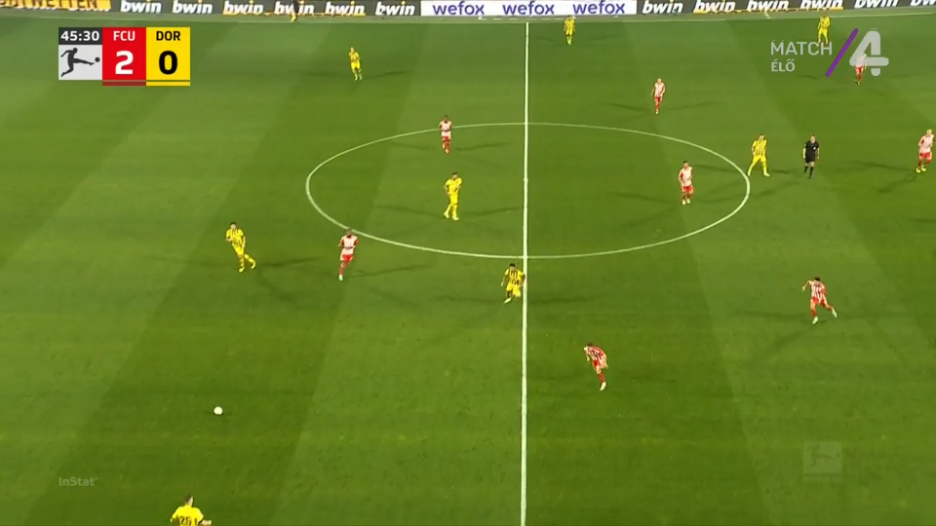
Particularly against sides whose attackers receive the ball to feet, this man-oriented approach works well. Here, Julian Ryerson forces Julian Brandt to turn back and recycle the ball instead of looking forward. Ryerson is now a Dortmund player, having signed in January.
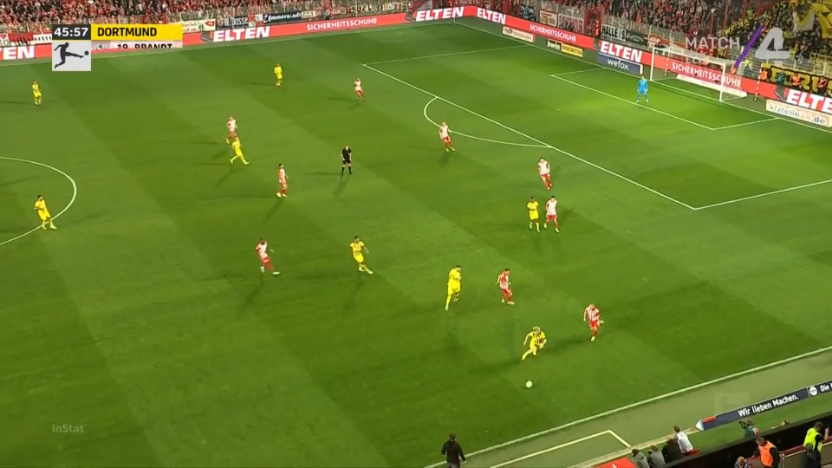
The wing backs are key to the system functioning going forward; they maintain the width and are the centre of chance creation in this side. Captain Christopher Trimmel is the best example of this. His ability to create chances from set-pieces and crossing from deeper areas gives Union an edge against teams.
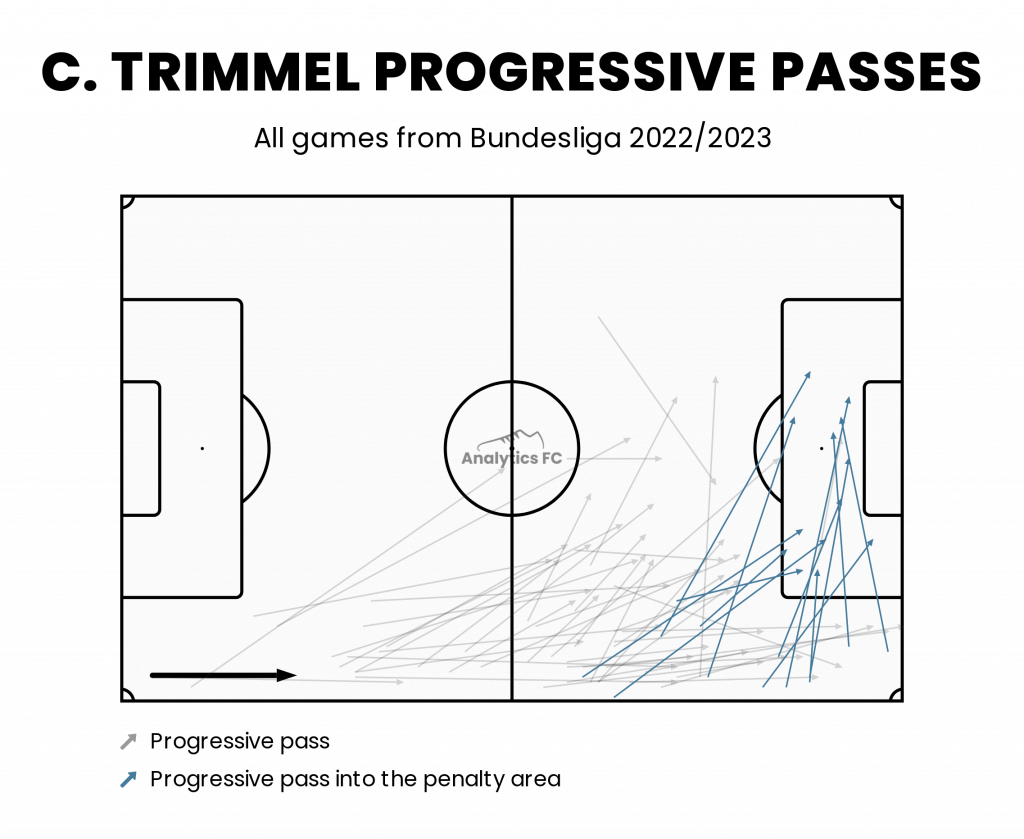
Indeed, crossing is a key part of their style of play and only 1.FC Koln have attempted more crosses from open play (209) than Union this season (177).
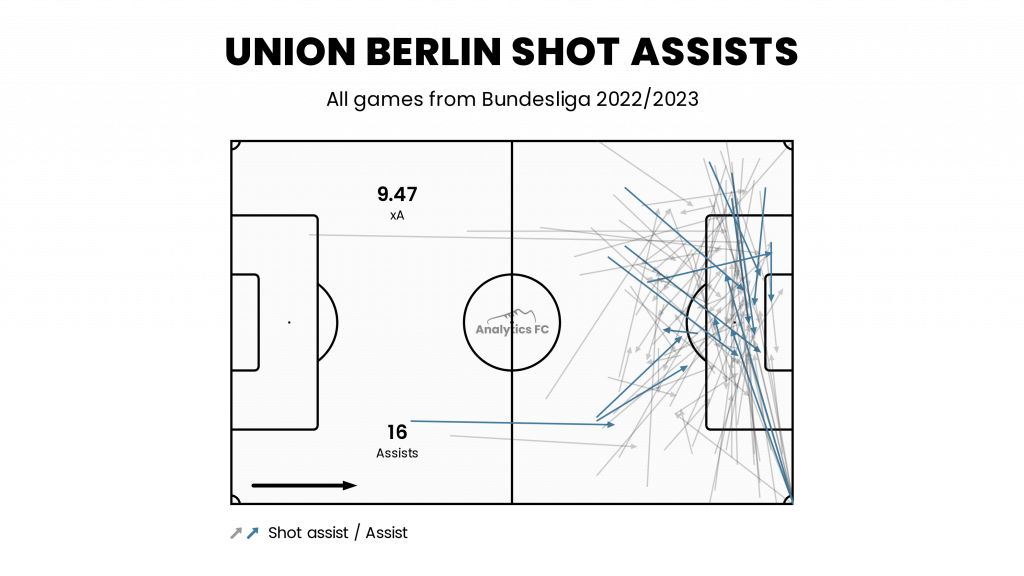
A traditional style of play
Looking at Union Berlin’s positioning here on the style map, you see the two key facets of their style of play – defending deep in their own half and in doing so, ‘parking the bus’ as it were along with overloading the wings when they can where their 8s and wing-backs will combine to create overloads to press and bait defenders into losing the ball.

This is where the likes of Sheraldo Becker are dangerous on the counter with space to run into. Becker is by far the quickest player in Fischer’s side and since Taiwo Awoniyi’s departure, has taken on the mantle of being the side’s marquee presence in attack.
According to data from the Analyst, Becker has 17 chance creating carries so far this season. In 21-22, he ended up with the fourth most chance-creating carries in the Bundesliga overall (44). He is key to Union’s style of play being effective with the few chances they do manage to create in open-play.
A quick look at their principles wheel gives us further context: against teams higher up the table, they commit even more to defending in a low-block and often resort to playing long to avoid manoeuvring through an opposition press. There is almost no counter-pressing and no play in transition, two obvious facets of a standard Gegenpressing team. What is interesting is how little much of the approach changes between the two forms of opposition, with only ‘low block’ showing a significant disparity on the two wheels.
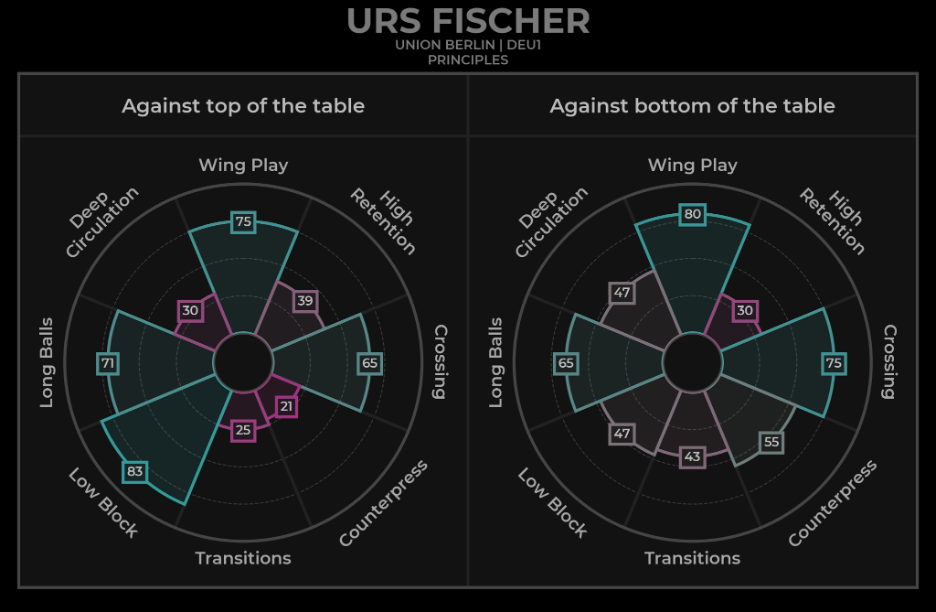
Retention of the ball high-up the pitch has never been a strength of the side and against opposition both above or below them, the data shows us a low rating on high retention, which is due to their functional approach to chance creation from wide areas and then attacking the box with their targets, which has been Jordan Siebatcheu this season.
A very different striker to Awoniyi, Siebatcheu, or ‘Pefok’ as he is popularly known, is a more traditional number 9 whose ability comes to the fore in the box as a target man.
Against sides below them in the table, the principles remain largely the same and in fact, they don’t back down, but double down instead of their wing-play and crossing. Against lesser opponents they are inclined to commit more players in forward areas and be more aggressive in their counterpressing.
This is an example from a game against Augsburg which they drew 2-2: the Union centre back in the middle is preparing to spray the ball wide in space for the wingback to exploit and then immediately cross the ball at the earliest opportunity.

Against Augsburg, Union managed to retain 60% of the ball, which is more than they have previously managed other opponents, but the next stage of evolution for this side is to be more effective with the ball.
Indeed, Union are fifth-bottom in the Bundesliga for build-up attacks, just nine in total according to the Analyst. All four sides worse than them for that metric are either in the relegation zone or battling to avoid the threat of relegation. They are also in the bottom six for sides with possession sequences of more than 10 passes, with 79, compared to Bayern’s 247 or Leipzig’s 205.
The approach isn’t conducive to high-quality chance creation and coupled with their tendency to be stronger without the ball, it is understandable to see why they have created the 2nd lowest xG from open-play this season, 9.21 (according to the Analyst).
They have over-performed somewhat against those numbers, scoring 14 goals from open-play, a larger over-performance than any other team in the top eight save Bayern (40 goals from an open play xG of 30.15). Union have also rediscovered their effectiveness from set-pieces, so far scoring a total of eight set-piece goals from an xG of just 2.74 according to the Analyst.
An overall tendency to over-perform on xG is obviously helpful, especially when trying to make the most of relatively few attacking chances. But it is Union’s ability to limit the opposition to low-quality chances overall that is most impressive and key to their performance this season. As we have said, no side in the Bundesliga has conceded lower xG from open-play than Union Berlin this season (9.61), according to the Analyst. The second best defence according to that metric are Bayern Munich, who are fractionally higher at 9.75 open play xGA.
All of these factors combine to make Union Berlin a very interesting case study in the context of German football specifically. Quite how long this approach continues to fuel their overperformance remains to be seen, but the success that has come for this little club from Kopenick due to their style of play has been first-class.
Header image copyright IMAGO/Sebastian Räppold/Matthias Koch

